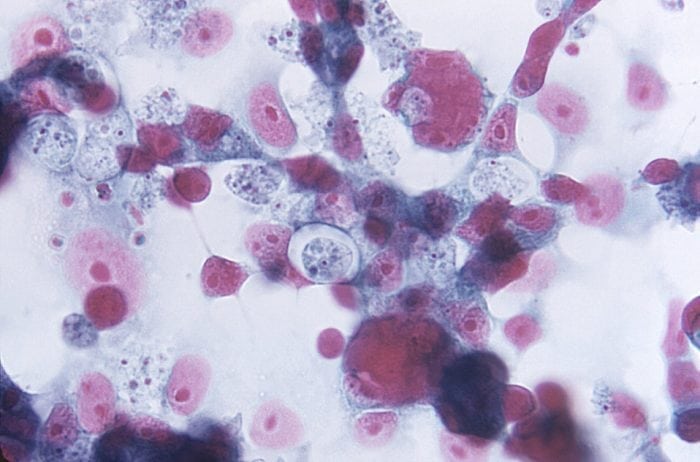
When it comes to waterborne pathogens and host-specific pathogens like human enteric viruses, it is easy to assume that they evolved through human interactions.
Yet as we now recognize various humans pathogens from parasitic protozoa (Toxoplasma gondii), through environmental bacteria (Vibrio cholerae and Legionella pneumophila) to giant viruses (Mimivirus), free-living amoebae (FLA) are probably the primary environmental/evolutionary source [Winiecka-Krusnell, 2009],[Van der Henst, 2018],[La Scola, 2005],[Abrahao, 2014], with humans just being an accidental host. Indeed, for millennia, FLA have been in an escalating arms battle, as prey develop novel virulence factors and predators seek to evade them.
Furthermore, our traditional water disinfection processes, such as chlorination, ozonation, UV light, and even heat are significantly reduced when viable pathogens are within FLA, including their natural giant viruses [Boratto, 2014]. However, only recently was the presence of infectious human enteric viruses demonstrated within common free-living amoeba known to colonize water systems [Atanasova, 2018].
What is particularly alarming and novel is the finding of a clinical coxsackievirus, B5, which remains infectious for over a year within amoeba. Hence, in places such as sewage treatment facilities or sewage sludge-amended soils, where high concentrations of human enteric viruses and FLA come into contact, their interaction does not appear to result in a digestion of human-infectious viruses. Compounding this concern is the increasing necessity for wastewater reuse to support urban development, where removal of human enteric viruses top the need for highest removal/inactivation of all groups of waterborne pathogens — where virions may not be effectively removed/inactivate by disinfection processes when internalized within FLA, their expelled vesicles, and very resistant cysts.
Digging further back into the evolutionary past of prey-FLA interactions [Guimaraes, 2016], amongst the amoeba-resisting bacterial pathogens they seem to have a larger genome than their more specialized hosts, suggesting adaptation to a range of prey. As a consequence, such ARB pathogens have a greater capacity to evade macrophages and other higher eukaryotic cell defense mechanisms. So, it was surprising to find a similar amoeba digestion evading “mechanism” with a human enteric virus – perhaps suggesting some genetic tricks more recently inherited through genetic interactions within amoebal trophozoites, as seen within the genome of Mimivirus [Moliner, 2010] or a more ancient capacity.
Whatever the reason, work is now in progress to better describe the fraction of enteric viruses that may evade waste/water treatment processes and then consider what additional treatment steps may be necessary to provide water fit-for-intended-uses. On the more fundamental science side, understanding FLA-virus interactions could even lead to novel ways to inactivate these persistent pathogens.
These findings are described in the article entitled Persistence of infectious Enterovirus within free-living amoebae – A novel waterborne risk pathway? recently published in the journal Water Research. This work was conducted by Nikki D. Atanasova, Rafik Dey, Candis Scott, and Qiaozhi Li from the University of Alberta, Xiao-Li Pang from the Provincial Laboratory for Public Health, and Nicholas J. Ashbolt from the University of Alberta and the Provincial Laboratory for Public Health.
References:
- Abrahao, J. S.; Dornas, F. P.; Silva, L. C.; Almeida, G. M.; Boratto, P. V.; Colson, P.; La Scola, B.; Kroon, E. G., Acanthamoeba polyphaga mimivirus and other giant viruses: an open field to outstanding discoveries. Virology journal 2014, 11, (1), 120.
- Atanasova, N. D.; Dey, R.; Scott, C.; Li, Q.; Pang, X. L.; Ashbolt, N. J., Persistence of infectious Enterovirus within free-living amoebae – A novel waterborne risk pathway? Water Res 2018, 144, 204-214.
- Boratto, P. V.; Dornas, F. P.; Andrade, K. R.; Rodrigues, R.; Peixoto, F.; Silva, L. C.; La Scola, B.; Costa, A. O.; de Almeida, G. M.; Kroon, E. G.; Abrahão, J. S., Amoebas as mimivirus bunkers: increased resistance to UV light, heat and chemical biocides when viruses are carried by amoeba hosts. Archives of virology 2014, 159, (5), 1039-43.
- Guimaraes et al. (2016) Acanthamoeba spp. as a universal host for pathogenic microorganisms: one bridge from environment to host virulence. Microbiol Res, 193, 30-38.
- La Scola, B.; Marrie, T. J.; Auffray, J. P.; Raoult, D., Mimivirus in pneumonia patients. Emerg Inf Dis 2005, 11, (3), 449-52.
- Moliner, C.; Fournier, P. E.; Raoult, D., Genome analysis of microorganisms living in amoebae reveals a melting pot of evolution. FEMS Microbiology Reviews 2010, 34, (3), 281-294.
- Van der Henst, C.; Vanhove, A. S.; Drebes Dorr, N. C.; Stutzmann, S.; Stoudmann, C.; Clerc, S.; Scrignari, T.; Maclachlan, C.; Knott, G.; Blokesch, M., Molecular insights into Vibrio cholerae‘s intra-amoebal host-pathogen interactions. Nat Commun 2018, 9, (1), 3460.
- Winiecka-Krusnell, J.; Dellacasa-Lindberg, I.; Dubey, J. P.; Barragan, A., Toxoplasma gondii: uptake and survival of oocysts in free-living amoebae. Exp Parasitol 2009, 121, (2), 124-31.









